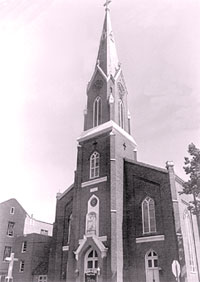| In 1839 Franz Joseph Rudolf was ordained in the
seminary chapel at Strasbourg. Only months before, Father Hailandiere
(representing the bishop of Vincennes, Indiana) had spoken to the Strasbourg
seminarians about the exciting and challenging possibilities in the mission
fields of North America. German priests were needed to serve the Catholics of
the Vincennes Diocese. Franz Joseph offered his service and, on October 29,
1844, arrived in Oldenburg as pastor. Immediately he began to dream and plan for
the future of the town and its people.
In 1848 Franz Joseph began construction of a new stone church which was consecrated in April 1850, as Holy Family Church. In early 1851 Sister Theresa Hackelmeier arrived from Vienna to found a community of Franciscan Sisters to work and teach in the parishes around Oldenburg. Finally, in 1862, a new brick church [the current Holy Family Church] was consecrated. The Franklin Democrat reported on December 5, 1862, that this new building was "the largest church edifice in the State." Realizing that he was getting weaker, Franz Joseph asked that the Franciscans continue his work when he died. Thus, in August of 1866 (just three months after Franz Joseph’s death) Friars Nicholas Wachter & Jacob Menchen came to Oldenburg from Cincinnati and established the beginnings of a long presence in the town. The friars lived in the old stone church with its distinctive onion dome. The space had been remodeled as a monastery containing twenty-four cells, two study rooms, a library, a kitchen and refectory. To reach the choir above the sanctuary of the new church, the friars walked across and open wood bridge. During the years 1873-1890 Holy Family Monastery served at various times as the novitiate and house of theology. Then, when the novitiate was moved to St. Anthony Friary in 1890, the monastery became the permanent house of theology for the Franciscans. The first ordination at the Oldenburg was that of the Bernardine Holthaus in the 1871-the same year that the Louis Haverbeck was appointed the first guardian of the friary. Space was getting more than tight. A choir wing was added to the church around 1890, and in 1894 land was purchased for a new monastery to be built facing Pearl Street-behind the brick church and incorporating the old stone church. AS the theology library grew a fireproof library wing was added in 1930. With the opening of St. Leonard College (Dayton) in 1958, Oldenburg became St. Joseph Brothers’ School until 1967 at which time history repeated itself. In 1967 the novitiate returned to Oldenburg until 1979 when (another repeat of history) it was moved back to St. Anthony. After a long public debate, the 1894 building and 1930 additions were demolished in 1986 revealing once more the old stone church (the onion dome of which was removed in 1949). Once again the stone building serves as home to the friars who serve the parish and the convent. Perhaps almost as much a landmark (of for fewer years) as the spires that define Oldenburg’s skyline is the man who has defined the Friar’s presence in the village for more than 30 years - "Friend" Leonard Kirejewski. |


